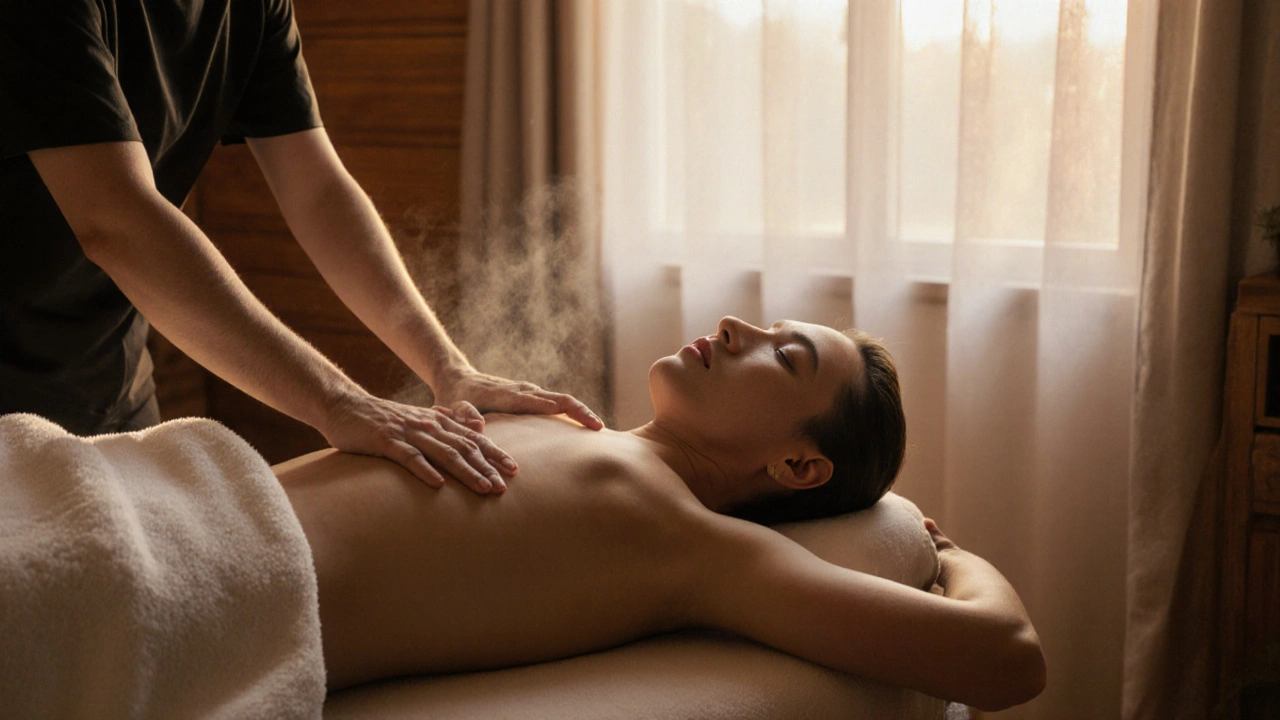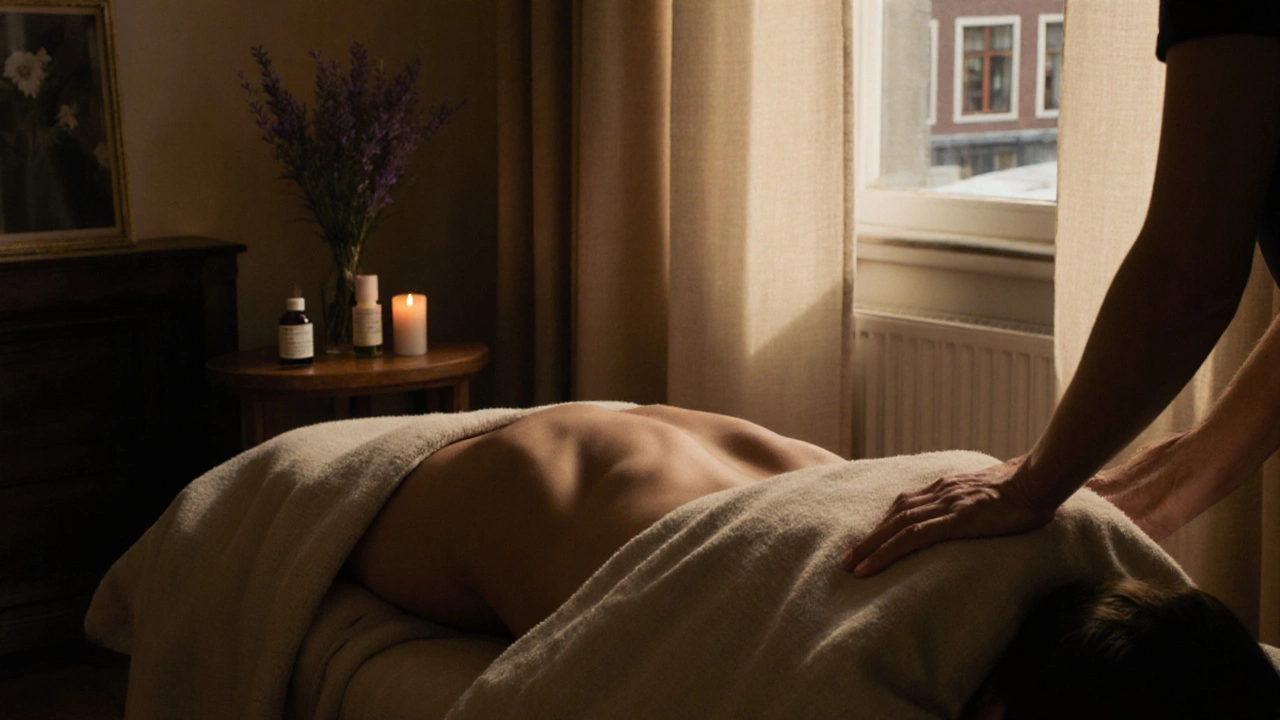Experience the Bliss of Wellness Massage for Mind and Body

You know that feeling when your shoulders are tight, your mind won’t shut off, and even your coffee doesn’t help? It’s not just being tired-it’s your body screaming for a reset. That’s where wellness massage comes in. Not just a luxury, not just a treat-it’s a necessary pause in a world that never stops. And yes, it’s as good for your brain as it is for your muscles.
What Is Wellness Massage, Really?
Wellness massage isn’t one single technique. It’s a philosophy. It’s about restoring balance-not just fixing sore spots, but helping your whole system breathe again. Think of it like tuning a guitar. You’re not just tightening one string; you’re bringing all the notes back into harmony.
Unlike deep tissue or sports massage, which target specific injuries, wellness massage focuses on overall calm. It uses gentle pressure, rhythmic strokes, and sometimes warm oils or aromatherapy to signal your nervous system: It’s safe to relax now. Your heart rate drops. Your cortisol levels ease. Your breathing slows. And for the first time in days, you actually feel present.
This isn’t new. Ancient cultures used touch for healing long before modern medicine. What’s changed is how we’ve forgotten it. We’ve turned massage into a chore, something you do when you’re in pain. But wellness massage is the opposite-it’s preventative. It’s the quiet act of caring for yourself before you break.
Why Your Mind and Body Crave This
Let’s be real: stress isn’t just in your head. It lives in your jaw, your lower back, your clenched fists. Chronic stress keeps your body in fight-or-flight mode. Your muscles stay tense. Your digestion slows. Your sleep gets ruined. And your mood? It spirals.
Wellness massage interrupts that cycle. A 2023 study from the Journal of Clinical Psychology found that people who received regular wellness massage reported a 41% drop in perceived stress levels after just four sessions. Not because of magic-because of biology.
When your skin is touched gently and consistently, your body releases oxytocin-the “cuddle hormone.” That’s the same chemical that bonds mothers to babies. It’s also what makes you feel safe, loved, and calm. No pills. No apps. Just hands, time, and stillness.
And it’s not just mental. Your circulation improves. Muscle tension unwinds. Inflammation decreases. Even your immune system gets a boost. One 2024 analysis of 28 clinical trials showed that regular massage increased natural killer cell activity by up to 22%. That’s your body’s frontline defense-activated by touch.
What Happens During a Session
Picture this: You walk into a quiet room. Soft lighting. The scent of lavender or sandalwood in the air. The table is warm. You lie down, covered with a soft towel. The therapist doesn’t start talking. They don’t ask for your pain scale. They just begin.
Their hands move slowly-long strokes along your back, gentle circles on your shoulders, light pressure on your feet. No music blasting. No rushed movements. Just rhythm. You start to notice your breath. You realize you’ve been holding it. You let go.
Most sessions last 60 to 90 minutes. You’re never forced to talk. You can close your eyes, drift off, or just listen to the quiet. If something feels too much, you say so. That’s part of the deal: you’re in control.
At the end, you don’t feel like you’ve been worked on. You feel like you’ve been held.
Types of Wellness Massage You Can Try
Not all wellness massages are the same. Here are the most common styles, each with its own flavor:
- Swedish Massage: The classic. Long, flowing strokes, light to medium pressure. Perfect if you’re new to massage or just want to melt into calm.
- Hot Stone Massage: Smooth, heated stones are placed on key points and glided over your skin. The warmth sinks deep into muscles, releasing tension you didn’t even know you had.
- Lymphatic Drainage Massage: Super gentle, almost feather-light. Helps your body flush out toxins and reduce puffiness. Great if you feel bloated or sluggish.
- Aromatherapy Massage: Essential oils are mixed into the oil or lotion. Lavender for calm, citrus for energy, eucalyptus for clarity. Your senses join the relaxation.
- Thai Massage: A bit more active. You stay dressed. The therapist uses their hands, feet, and knees to guide you through stretches. It feels like yoga with a partner.
You don’t need to pick the “right” one. Start with Swedish or hot stone if you’re unsure. Most therapists will adjust based on how you feel that day.

How to Find the Right Practitioner
Not every massage therapist is trained in wellness. Some focus on pain relief. Others on speed. You want someone who listens, not just manipulates.
Look for these signs:
- Their website or bio mentions “holistic,” “mind-body,” or “therapeutic relaxation.”
- They offer a brief consultation before the session-asking about your stress, sleep, energy levels.
- They don’t rush you in and out. There’s time to settle in.
- They respect your boundaries. No unsolicited touch. No pressure to undress more than you’re comfortable with.
Check reviews-not just star ratings, but the stories people tell. “I cried during my session and didn’t feel judged” is a good sign. “I fell asleep and woke up refreshed” is even better.
Try local wellness centers, yoga studios, or holistic health clinics. They’re more likely to prioritize calm over speed.
What to Expect in Terms of Cost
Wellness massage isn’t cheap-but it’s not meant to be a weekly grocery run either. Think of it like a monthly subscription to your sanity.
Here’s what you’ll typically pay:
- 60-minute session: $70-$110
- 90-minute session: $100-$160
- Package deals (5 sessions): 10-20% off
Prices vary by city, experience of the therapist, and whether it’s in a spa or a quiet home studio. Don’t go for the cheapest-massage is a skill, not a commodity. But you don’t need to break the bank either. Many therapists offer sliding scales or community rates.
Book in advance. Popular slots fill up fast, especially on weekends. And if you’re trying it for the first time, go midweek. The studio will be quieter. The therapist will have more time for you.
What You Should Avoid
Not every massage is safe for everyone. Here’s what to watch out for:
- Too much pressure: If it hurts, it’s not healing. Wellness massage should feel like sinking into a warm bath, not getting pounded.
- Overstimulating scents: Some people are sensitive to strong oils. Ask for unscented options if you’re unsure.
- Unlicensed practitioners: No certification? Walk away. In most places, licensed therapists must pass exams and carry insurance.
- Pushy upsells: If they try to sell you a $500 detox package after your first session, that’s a red flag. Real wellness doesn’t pressure.
Also, avoid massage if you have a fever, open wounds, or recent surgery. Always tell your therapist about any health conditions-even if you think it’s unrelated.

Wellness Massage vs. Deep Tissue Massage
| Aspect | Wellness Massage | Deep Tissue Massage |
|---|---|---|
| Primary Goal | Relaxation, stress relief, mind-body balance | Release chronic muscle tension, treat injury |
| Pressure Level | Light to medium | Deep, focused, sometimes intense |
| Speed of Movement | Slow, rhythmic, flowing | Slow, deliberate, targeted |
| Best For | High stress, poor sleep, anxiety, burnout | Sports injuries, stiff necks from desk work, chronic pain |
| After Feel | Calmer, lighter, emotionally released | Sore, but less tight-like after a good workout |
| Frequency Recommended | Weekly or biweekly for ongoing balance | Every 2-4 weeks, as needed for pain |
They’re not competitors. They’re different tools. Use wellness massage to keep your system calm. Use deep tissue when you need to fix something broken. Many people do both-weekly wellness to stay balanced, monthly deep tissue to clear old knots.
Frequently Asked Questions
Can wellness massage help with anxiety?
Yes. Many people report a noticeable drop in anxiety after just one session. The physical touch lowers cortisol, increases serotonin, and helps your nervous system shift out of fight-or-flight mode. It’s not a replacement for therapy, but it’s a powerful support tool.
Do I need to take my clothes off?
No. You’re always covered with a towel. Only the area being worked on is exposed. Most people keep their underwear on. Some prefer to wear shorts and a tank top. It’s your space. Tell the therapist what feels right.
How often should I get a wellness massage?
Once a month is a good start for most people. If you’re under high stress, try every two weeks. Athletes or people with chronic tension might benefit from weekly sessions. Listen to your body. If you feel lighter, calmer, and sleep better-you’re on the right track.
Can I do wellness massage at home?
You can’t fully replicate a professional session, but you can create moments of calm. Try self-massage with a foam roller or tennis ball. Use warm oil and slow strokes on your neck, shoulders, and feet. Pair it with deep breathing. Even 10 minutes a day makes a difference.
Is wellness massage safe during pregnancy?
Yes-when done by a therapist trained in prenatal massage. They’ll use special positioning and avoid certain pressure points. Many pregnant women find it the only thing that eases their back pain and helps them sleep. Always check with your doctor first.
Ready to Feel Like Yourself Again?
You don’t need to wait until you’re broken to start caring for yourself. Wellness massage isn’t a reward for surviving the week. It’s a way to stop surviving-and start living again. It’s the quiet space between your thoughts where peace actually lives.
Book that session. Say yes to the warmth, the silence, the hands that know how to listen without words. You’ve earned it. Not because you’ve earned it through hard work-but because you’re human. And humans need to be held.



Dale Loflin
November 10, 2025 AT 08:52Okay but let’s be real-this isn’t massage, it’s neurochemical hacking. You’re basically doing a soft reboot on your autonomic nervous system through somatic entrainment. The oxytocin surge? That’s your body’s built-in SSRIs without the side effects. And the cortisol drop? It’s not relaxation, it’s epigenetic recalibration. We’ve been conditioned to see touch as transactional, but this is biofeedback as ritual. The therapist isn’t just rubbing your back-they’re conducting a symphony of parasympathetic dominance. No pills. No apps. Just ancient neurobiology reactivated by human presence.
Nancy Espinoza
November 11, 2025 AT 19:24imagine if your body could talk and it just said hey im tired and you actually listened for once like wow
Chancye Hunter
November 12, 2025 AT 18:48This made me cry in the middle of my cubicle 😭 I’ve been getting weekly massages since my burnout last year and honestly? It’s the only thing that keeps me from quitting my job. Also-lavender oil is magic. I keep a rollerball in my purse now. 🌿
Neha Sharma
November 13, 2025 AT 21:02People act like this is some new age trend but my grandma in Kerala gave me oil massages since I was 3. We didn’t need a spa to know touch heals. Now everyone’s selling it as a luxury like it’s not basic human biology. 🤦♀️
Krunal Ronak
November 15, 2025 AT 19:52Wait… so you’re telling me this is just a front for Big Spa’s new mind control program? They’re using lavender and warm stones to lower your cortisol so you become docile. You think you’re relaxing? You’re being primed for consumer compliance. The 41% stress drop? That’s not science-that’s a placebo engineered by corporate wellness conglomerates. Who funds these studies? Who owns the spas? Who owns your breath now?
Abhinav Singh
November 16, 2025 AT 20:28I used to think massage was just for rich people or athletes. Then I got one after my dad passed. Didn’t know I was holding so much grief in my shoulders until my therapist gently pressed into my trapezius and I just… started sobbing. No words. Just tears. That’s when I realized-your body remembers everything your mind tries to forget. You don’t need a reason to get a massage. You just need to be alive.
Now I go every three weeks. Even if I’m broke. Even if I’m tired. Even if I don’t ‘deserve’ it. Because I’m here. And that’s enough.
g saravanan
November 18, 2025 AT 17:58The philosophical underpinning of wellness massage is not merely physiological but ontological-it is an embodied reclamation of presence in a world that has commodified time, attention, and stillness. The hands of the practitioner do not merely manipulate fascia; they perform a sacrament of non-intervention, a quiet resistance against the hegemony of productivity. In the stillness induced by rhythmic pressure, the self is not repaired-it is remembered. The body, long relegated to the status of instrument, is restored to its primary dignity: vessel of consciousness, temple of sensation, sanctuary of breath. To receive massage is to consent to being human, not functional.
It is no accident that the most ancient healing traditions-from Ayurveda to Traditional Chinese Medicine-elevated touch above all other modalities. The skin is the largest organ of perception, and when touched with intention, it becomes the portal through which the soul exhales.
Kate Cole
November 20, 2025 AT 12:01First, it’s ‘wellness massage,’ not ‘wellness massage.’ You’re missing the hyphen. Second, the study citation is vague-Journal of Clinical Psychology doesn’t have a 2023 issue with that exact data. Third, ‘natural killer cell activity increased by 22%’? That’s from a single meta-analysis with questionable sample sizes. And fourth-why is ‘Thai massage’ listed as ‘yoga with a partner’? That’s inaccurate and reductive. This article reads like a spa brochure written by someone who skipped fact-checking.
Don’t get me wrong-I love massage. But let’s not turn pseudoscience into spiritual virtue. Real healing doesn’t need hype. It just needs honesty.